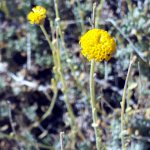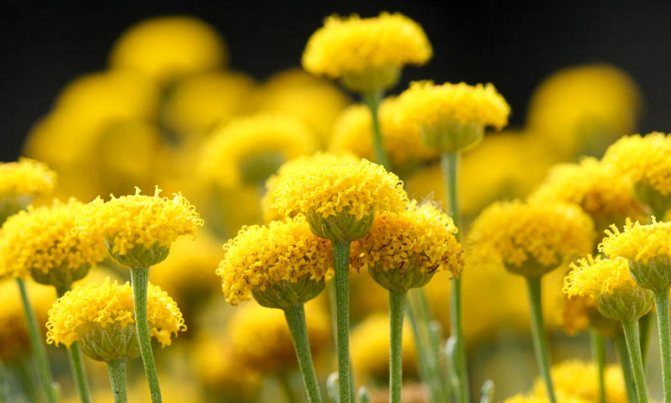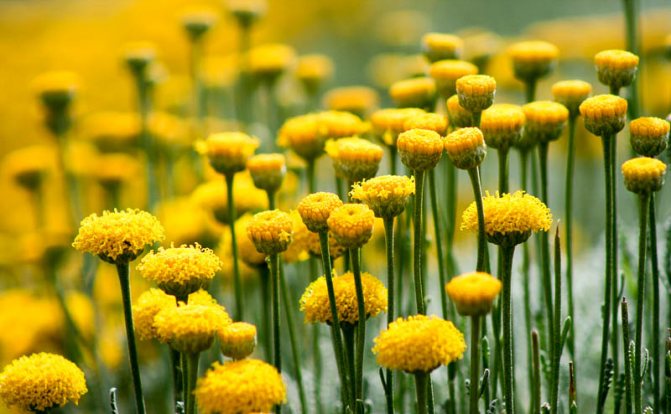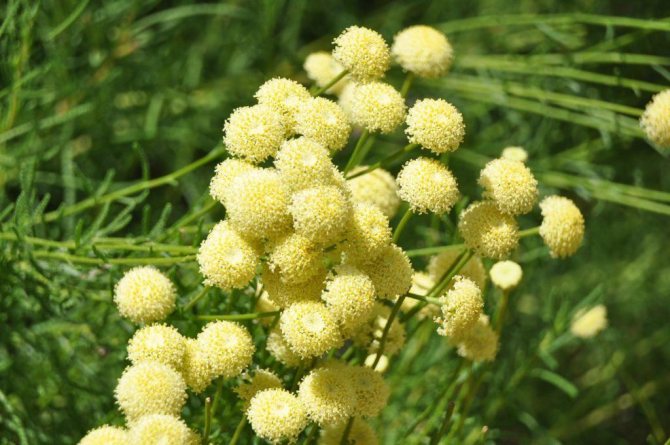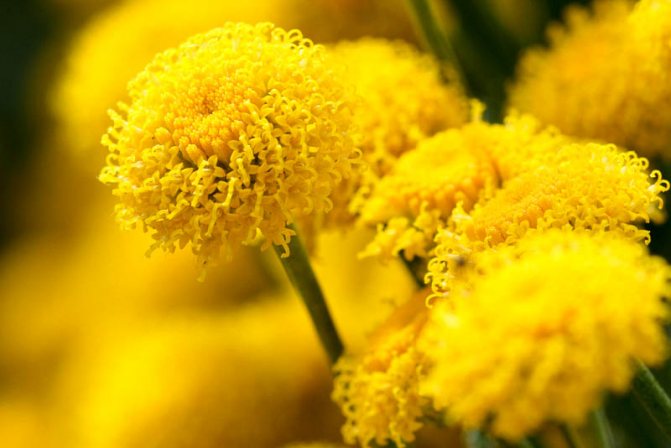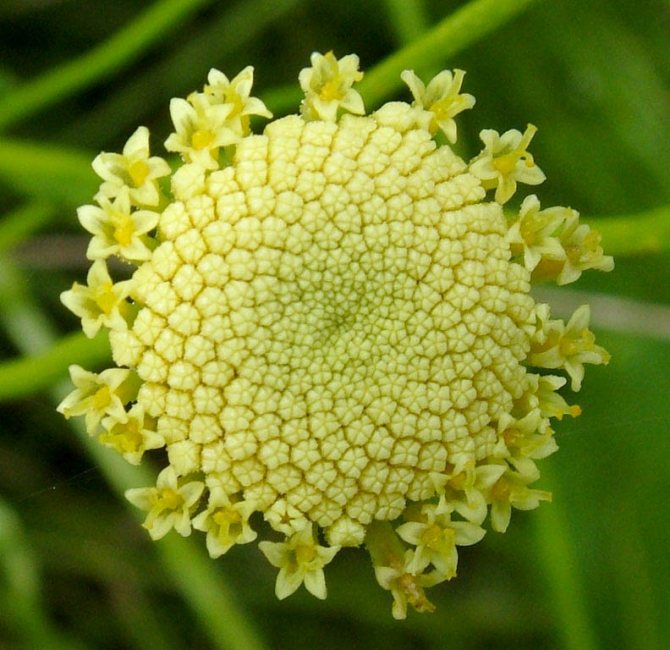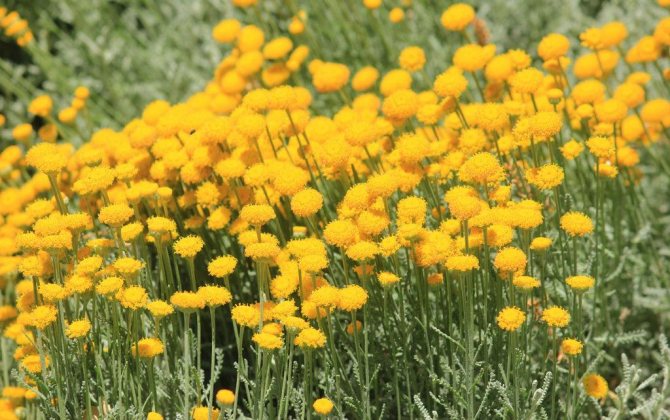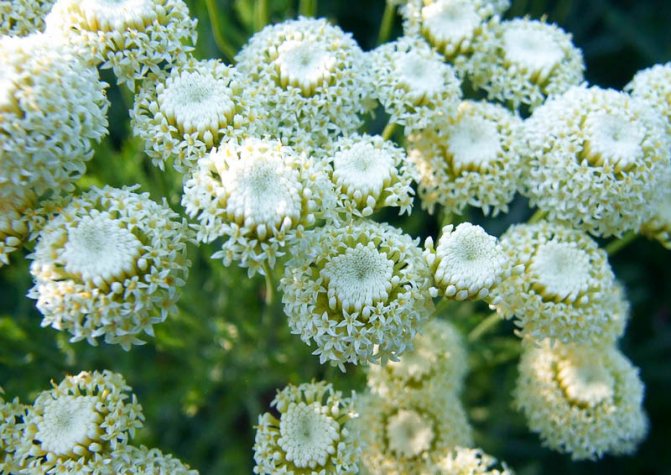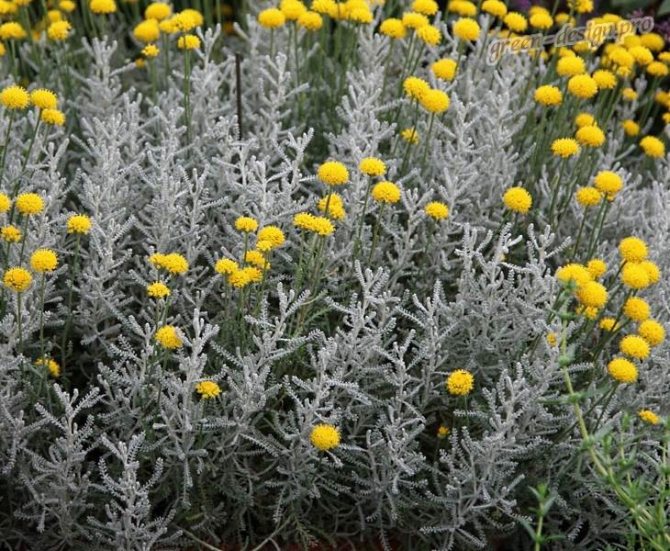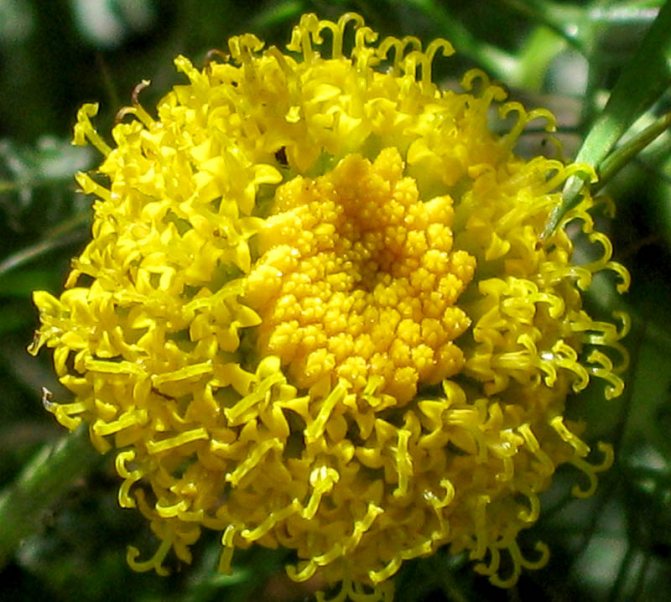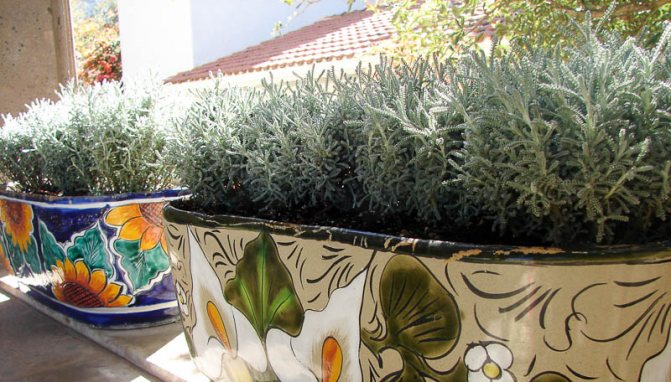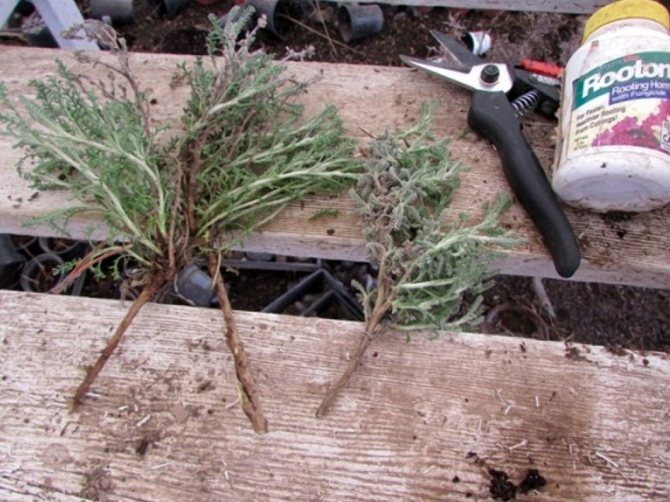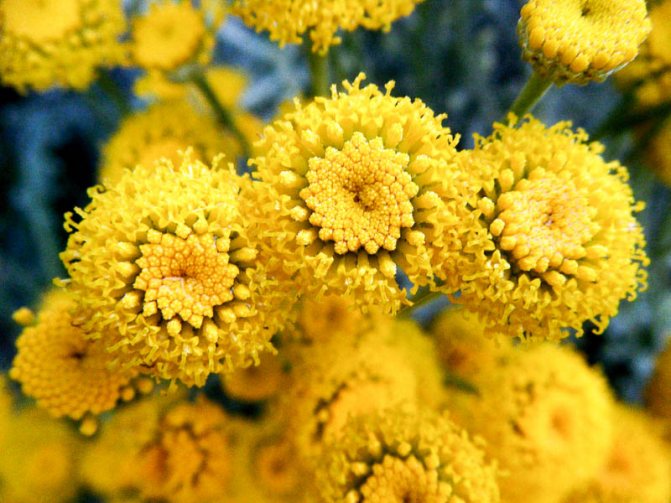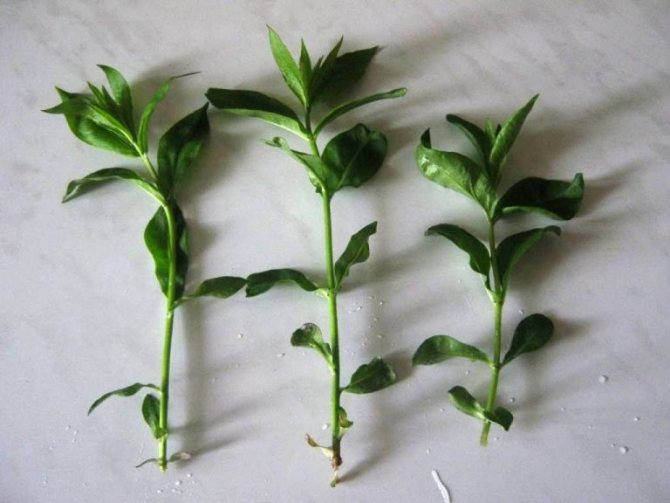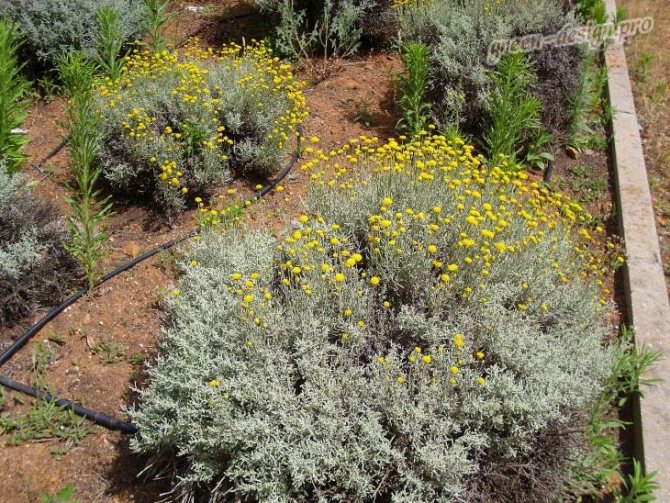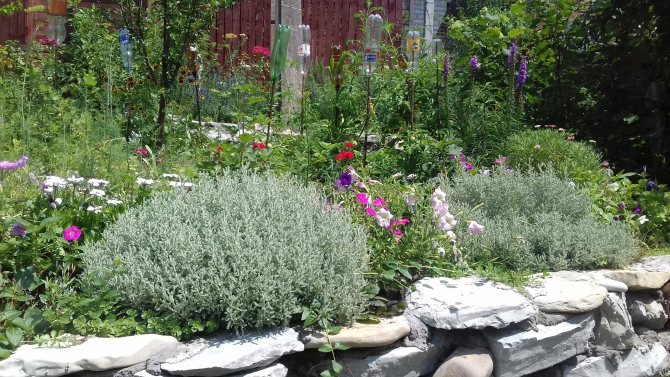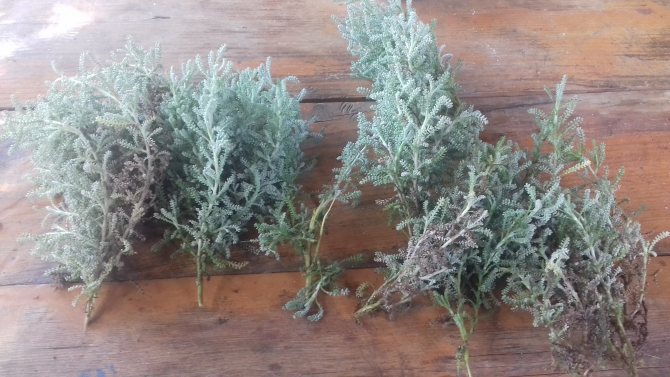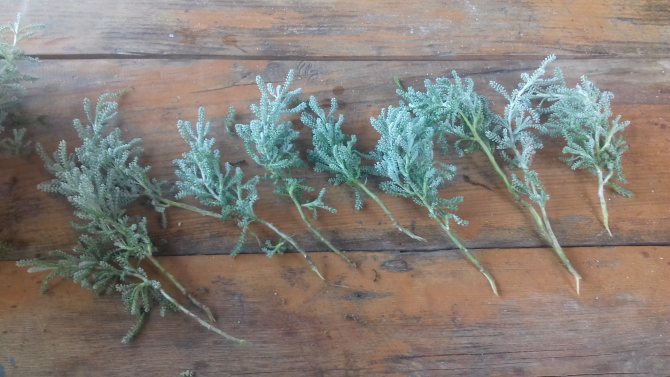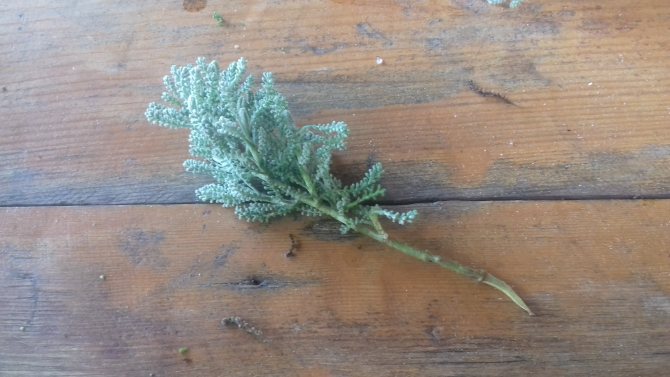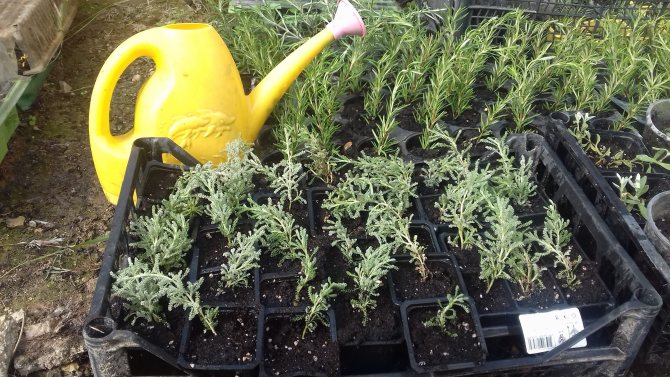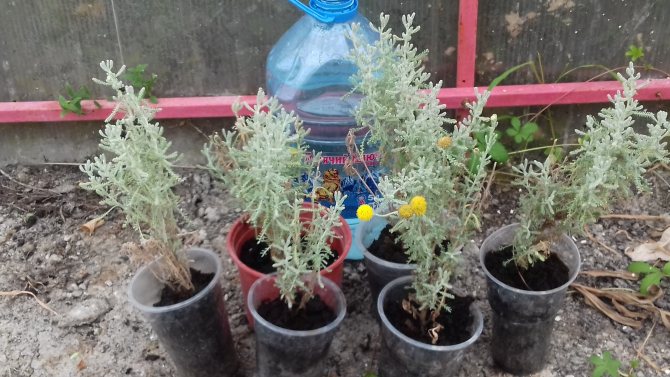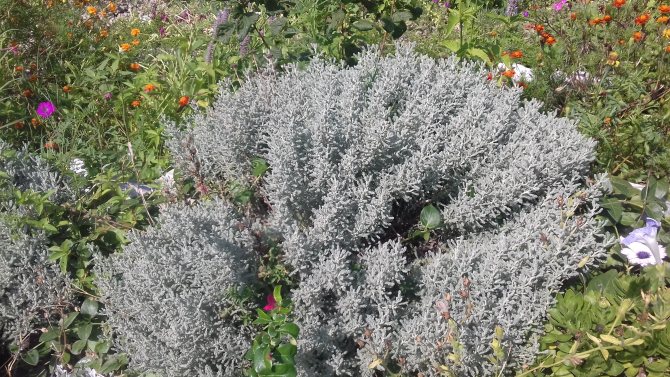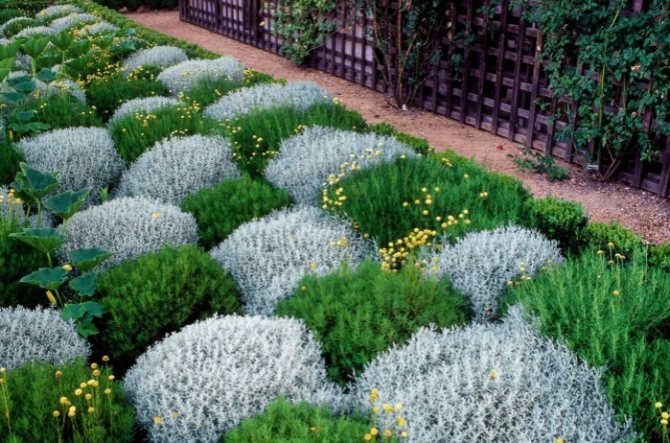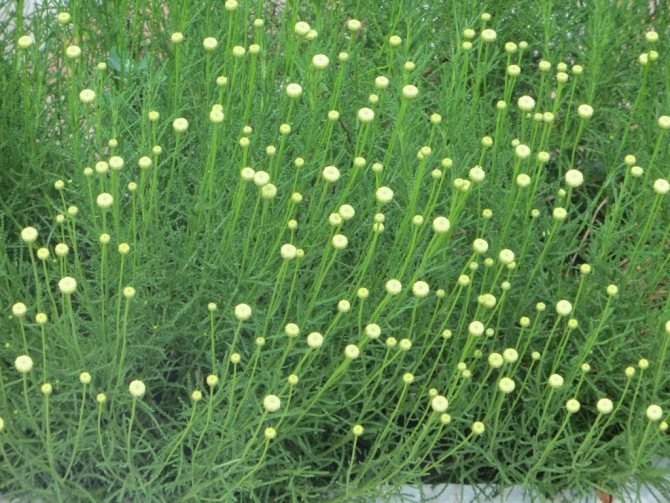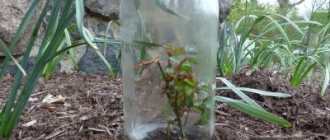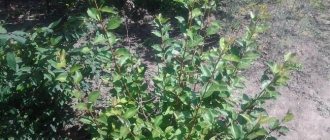Santolina is an ornamental plant belonging to the Astrovye family. The evergreen shrub is most widespread in the south of the European part of the continent. It is notable for its versatility, which is not limited to interior decoration. Thanks to the essential oils included in the composition, the plant is used as a spice and also repels moths. Perennial includes many garden and indoor species.
Santolina characteristic
The flowering shrub of santolin consists of feathery leaf plates with a white pubescent surface, tall thin stems about 20 centimeters in height, fragrant spherical inflorescences of a white or yellow shade about two centimeters in diameter. The flowering period continues throughout the summer season. The height of the bush is from 10 to 60 centimeters. Landscape designers use highly decorative santolina for landscaping areas, on alpine slides and rocky gardens, in flower beds and flower beds.
Botanical description
Santolina is a highly branching shrub (semi-shrub) with a rounded shape and a pronounced spicy aroma. It belongs to the Asteraceae family.
Santolina flowers are collected in small dense inflorescences and have a yellow or cream color. One inflorescence is located on one thin stem, which extends beyond the crown by 15-25 cm. Santolina flowers, like the leaves of the plant, have a spicy aroma. The plant is not tall. Depending on the species, the height of the plant varies from 10 cm to 60 cm, in rare cases it reaches 1 meter.
Santolina is attractive not with flowers, which resemble buttons in their appearance, but with an unusual shape of leaves - in one species it resembles a cypress twig, in others it is narrow, feathery, elongated, silvery, green, with or without edging.
Your garden will be beautifully decorated with such flowering shrubs as David's buddley, weigela, heather, hibiscus, hydrangea, jasmine, spiraea, lilac, forsythia.
Growing santolin from seeds

Sowing seeds
Seed material must be hardened for thirty or sixty days before sowing. For this, the seeds are placed on the bottom shelf of a household refrigerator. In the last week of February or in the first days of March, you can sow seeds for seedlings.
Rasasada santolina
For sowing santolina seeds, wooden or plastic containers with a special soil mixture for flowering garden plants are suitable. The soil must first be slightly moistened. The seeds are scattered over the surface, crushed with a thin layer of sand and covered with glass or plastic wrap. Seed boxes should be placed in a bright room with a temperature of about 25 degrees Celsius and left for 15-20 days until shoots appear.
The cover is removed after the seedlings appear. Caring for santolina seedlings consists in regular moderate moisture and loosening of the soil. After the formation of 2-3 full-fledged leaves on the plants, a pick can be made. Seedlings are transplanted into peat pots or plastic cups, two copies each. The grown strong seedlings begin to harden 2-3 weeks before transplanting into open ground.
Santolina seedlings are best transplanted into a garden or flower garden after the established warm weather in a well-warmed ground.The end of May or the first week of June is the most favorable time for this. Experienced gardeners recommend transplanting santolina on a cloudy day or after sunset.
The size of the planting holes should slightly exceed the size of the earthen ball on the root of the seedling. The plant is placed in a hole, sprinkled with soil, watered. The volume of irrigation water is moderate.
The role of the plant in landscape design, options for use
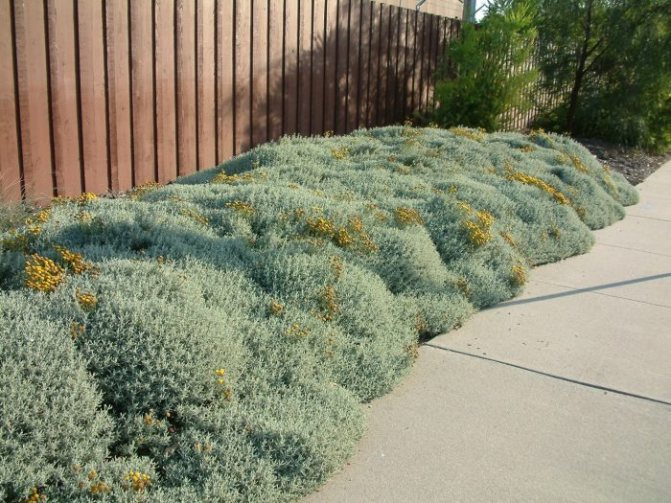

Small bushes look unusual and versatile in combination with other plants
Perennial is widely used in garden design, there are several options for its successful application:
- In the foreground of the flower beds, like a low hedge.


Santolina will help to carry out the correct zoning of the alpine slide
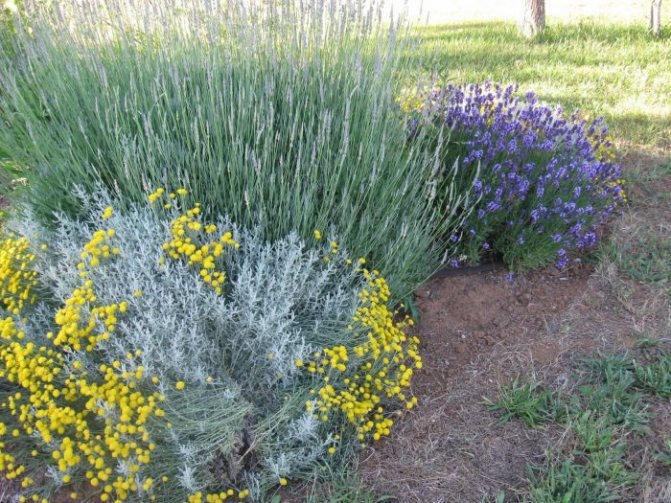

Santolina combined with nana lavender and dutch lavender


Such trees can be taken out on the terrace in summer.
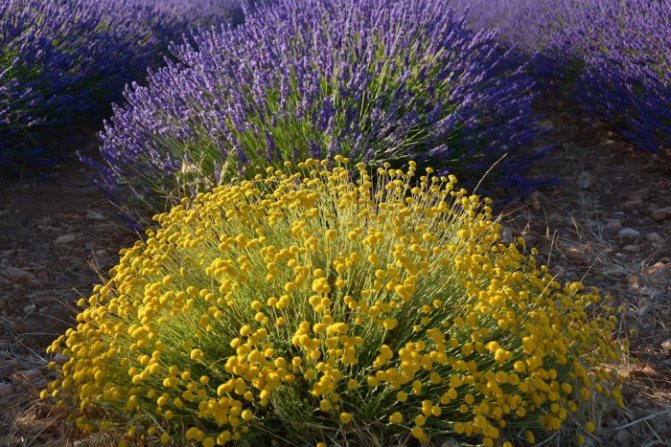

Santolina in combination with lavender looks great both in flowerpots and outdoors
Planting santolina outdoors
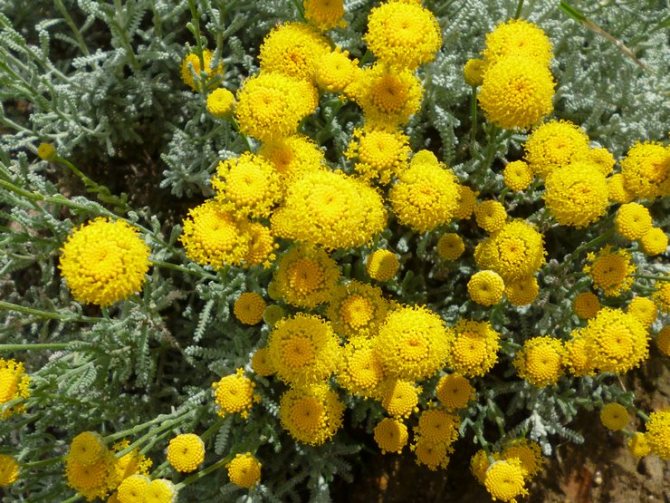

A favorable place for planting and growing santolina will be an open sunny area on a small hill, but protected from gusts of wind. Penumbra will negatively affect the decorative effect of a flowering bush. The plant will look messy and shapeless. The soil should be lean (stony or sandy loam) with a neutral reaction and moderately dry. The proximity of groundwater, stagnation of water during snow melting or after heavy rainfall is not allowed. Wet clayey patches can promote root rot and often lead to plant death. We need land with good water and air permeability. Fertile soil is also not desirable, as it will lead to abundant growth of the leaf mass and less active flowering.
Before planting seeds or seedlings of santolina, the land must be dug up. Heavy clayey soil must be drained. To do this, when digging, fine crushed stone or coarse sand is added to it.
Caring for Santolina in the garden
Watering
Planting and caring for santolina in the open field is quite simple, even a novice grower will not have any problems. Santolina is a drought-resistant plant that requires moderate watering in hot weather and gets by with natural moisture with frequent precipitation. Excess and lack of moisture in the soil can lead to the death of the shrub. With a lack of water, the flowers will dry out, and with an excess of water, root rot will appear, the shoots will begin to turn yellow and wither en masse. The most optimal time for watering Santolina is the appearance of a dried up topsoil. Even tap water is suitable as irrigation water, but it is still better to use settled and slightly warm water.
The soil
The soil requires constant care in the form of weeding and loosening. Weed vegetation must be removed constantly and in a timely manner, preventing its growth. It is recommended to loosen the area around the shrub from time to time so that the root system receives a sufficient amount of water and air.
Top dressing
Since the surplus of nutrients in the soil negatively affects the flowering process of santolina, it is recommended to apply fertilizers in the form of a very weak nutrient solution. It should be much weaker than the instructions on the package recommend. Top dressing for santolina should be applied 3-4 times a month with an interval of 7-10 days. From April to August, complex mineral fertilizers with a low nitrogen content are used. After the end of flowering, feeding is stopped.
Pruning
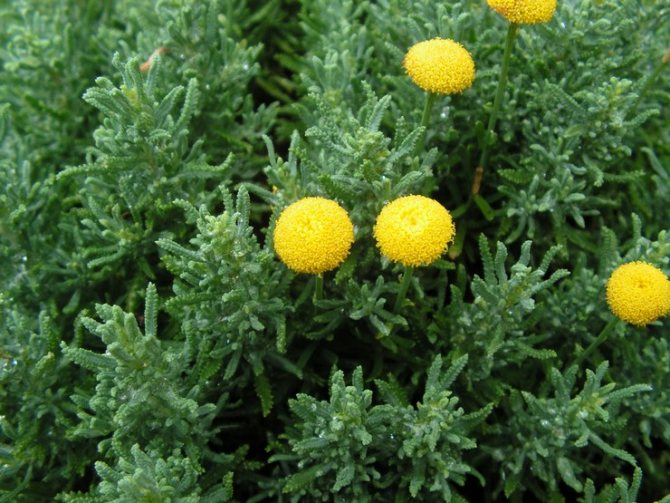

Regular "haircuts" help to maintain and maintain the attractive appearance of flowering crops. It is necessary to constantly remove wilted inflorescences and damaged shoots. At the end of August, the shoots of Santolina are cut by about 60-70%.
Wintering
There are two ways to save the heat-loving santolina plant in winter - move it to a living space or build a reliable shelter.
Santolina feels great as a houseplant. It is dug up in early autumn, planted in a flower container and placed in cool conditions. The average temperature in the room is 15-18 degrees Celsius. In this room, the plant will perfectly survive until the arrival of spring.
On an open area in mid-autumn, the land near the shrub must be covered with a mulch layer (for example, spruce needles or a mixture of wood ash and river sand) or spruce branches. After that, cover the entire bush with a large wooden box and any covering material - polyethylene, lutrasil or roofing material. For reliability, you can put a load on top so that strong gusts of wind do not overturn the entire structure. In early spring, the structure can be disassembled, and the site can be covered with a layer of compost.
Planting a plant
In order for the shrub to show itself in all its glory, a warm place, well-lit by the sun, is chosen for it. Prefers santolina soil poor in nutrients, the only thing it needs is good drainage. Therefore, this culture is simply irreplaceable for creating landscape design on a rocky area. You can buy seedlings in the fall, but then you will have to plant them in the room. The main thing is that the shrub must have healthy leaves, with a characteristic color for the variety, not damaged.


The optimal time for planting santolina is spring
Before planting seedlings in spring soil, the soil should be dug onto a shovel bayonet, sand should be added if the soil is heavy. When several shrubs are planted, they dig a trench, remove the Mediterranean guest from the container, straighten the roots and place them at intervals of 0.1 to 0.3 m.Further, soil is poured into the trench, slightly compacted around young plants, watered abundantly until the seedlings will take root.
Diseases and pests of Santolina
Santolina is highly resistant to all pests and diseases. Problems with her health can arise only with improper care and maintenance.
For example, with an excess and stagnation of moisture in the soil, rotting of the root system begins. Signs of the disease are shoots that turn yellow in the middle of the summer season. Excess watering should be stopped immediately and returned to normal over time. The shrub must be treated with a fungicide and the culture must be left without moisture for a while. With timely rescue measures, the flowers will surely restore their attractiveness, the disease will recede.
Santolin can lose its decorative effect with the wrong choice of the place of cultivation. Shady conditions, lack of sun and light, too dry soil - all this can cause the death of the plant. If the shrub is transplanted in time to a place more comfortable for it, health problems will stop.
Reproduction of santolina


Reproduction by dividing the bush
It is recommended to divide the bush once every five or six years. Such a procedure is at the same time a way of rejuvenation, plant renewal. In early spring, an adult shrub must be removed from the ground and the rhizome should be cut into several parts using a sterile knife. Each split section should have healthy and strong shoots and strong, intact roots. Places of cuts are immediately sprinkled with charcoal or activated carbon powder, after which santolina seedlings are planted in a permanent place.
Propagation by cuttings
At the beginning of March, green cuttings of at least 5 centimeters in length are cut from the mother plant, dipped for a while in a container with a stimulant for root formation and planted in wet sand.It is recommended to cover each stalk with a glass jar or a cut plastic bottle to create the greenhouse conditions necessary for good rooting. After the appearance of several leaves on the cuttings, the cover can be removed. The formation of a full-fledged root system occurs within 50-60 days. In late May or early June, cuttings can be transferred to the open ground of a flower garden or flower bed.
Step-by-step instructions for propagation by seeds and cuttings
When a shrub is propagated by seeds, the seedling method is used. Frost-resistant species are planted in the ground so that a powerful root system has time to form by winter.
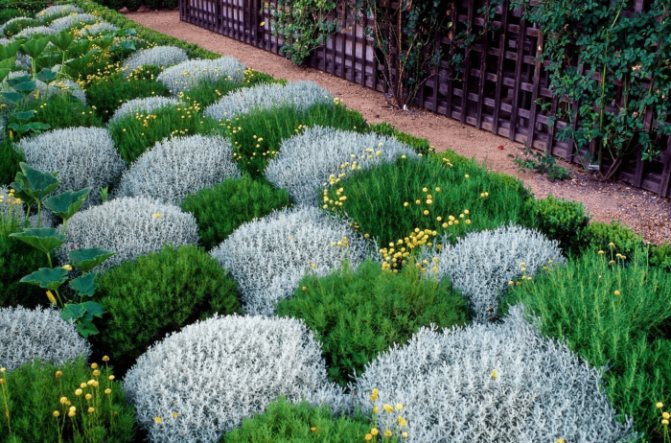

Planting shrubs in a checkerboard pattern is a good design solution
Sowing seeds in a permanent open place is carried out in early summer, when the soil is well warmed up. And they are sown for seedlings at the end of winter. Before sowing, the seeds are stratified in the refrigerator, keeping them in a damp cloth for a month. The sowing process is carried out in the following sequence:
- Finished seeds are placed in wide and shallow containers filled with equal parts of turf and sand. The seeds are deepened into the ground a couple of centimeters, and the containers with them are placed in a bright and warm place, where the temperature is 18–20 degrees.
- In such conditions, sprouts appear in 2-3 weeks.
- When 2-3 true leaves are formed, the seedlings dive into separate pots, and they are transplanted to a permanent place in late spring - early summer.
Read also Which group does the peas belong to?
When rooting cuttings, the following rules are observed:
- Only green shoots of the current year are suitable for reproduction, lignified cuttings of the root system do not form. The length of the cuttings is 8–15 cm. Cutting is practiced in late winter or early spring.
- Young twigs are cut with the part of the trunk on which they grow.
- They are treated with the stimulant Kornevin.
- Then they are planted in a mixture of sand and leafy earth in proportions of 2 to 1.
- Cover with a transparent container, raised daily for ventilation.
- They are watered regularly, avoiding flooding.
- Rooted plants in groups of three are planted in individual pots. At the same time, for their better branching, pinch the crown.
- They are transplanted to a permanent place in June.
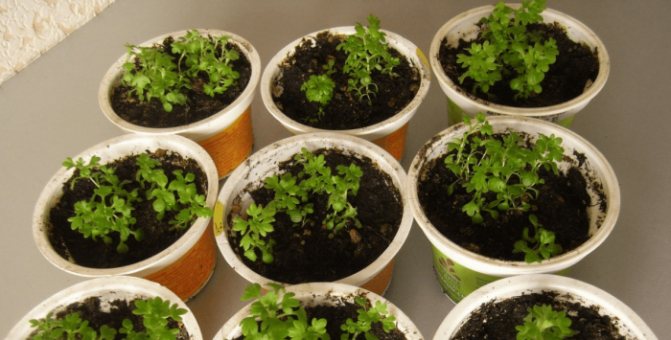

From the pot you have to plant bushes in the garden
When planting seedlings in spring, the soil is dug to the depth of a shovel bayonet. Sand is added to heavy soil. Landing is carried out as follows:
- The earth is dug to a depth of a third of a meter.
- A Mediterranean guest is removed from the pot, spreading the roots, and placed in trenches, observing the interval between neighbors of 10-30 cm, and for tall species - half as often.
- They are covered with soil, then compacted in the root circle and watered abundantly for 3-4 days.
- Watering is reduced after the seedlings are rooting.
Types and varieties of santolina with a photo
Santolina virens
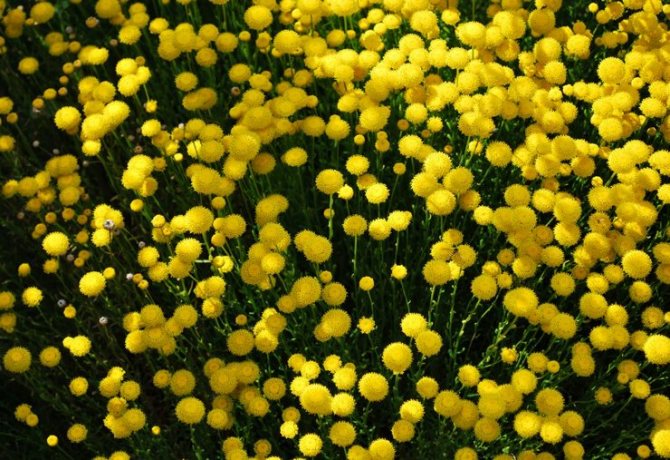

Or santolina greening - a hardy cold-resistant species that retains its viability even at low subzero temperatures of about 7 degrees below zero. Openwork foliage makes the plant light and translucent in appearance. It blooms with globular inflorescences of a white shade. The aerial parts of plants are used for food as a spice.
Santolina rosmarinifolia
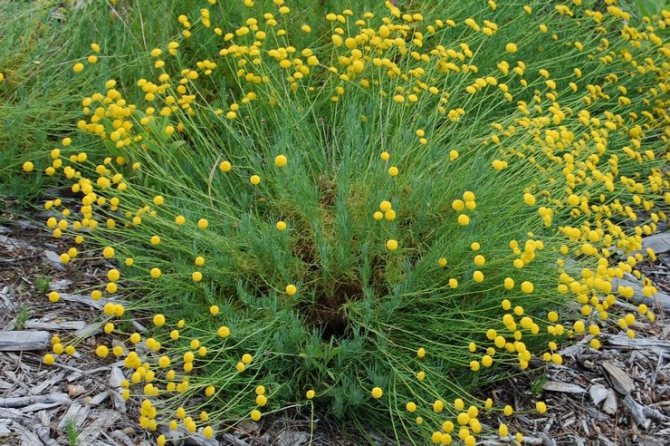

A decorative and spicy look popular with landscape designers and culinary professionals. Long and thin leaf plates contain a large amount of essential oils, which give them a bright olive aroma and unique taste.
Santolina elegans
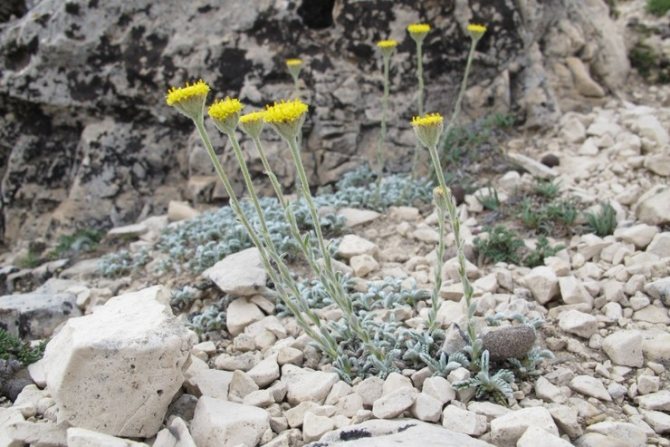

Highly decorative, attractive look with graceful lines and individual requirements for maintenance and care. The shrub prefers special temperature conditions, corresponding to those of a greenhouse or indoor. Negatively refers to high humidity and stagnation of water in the soil. Differs in high peduncles and large yellow balls-baskets.
Santolina neapolitana
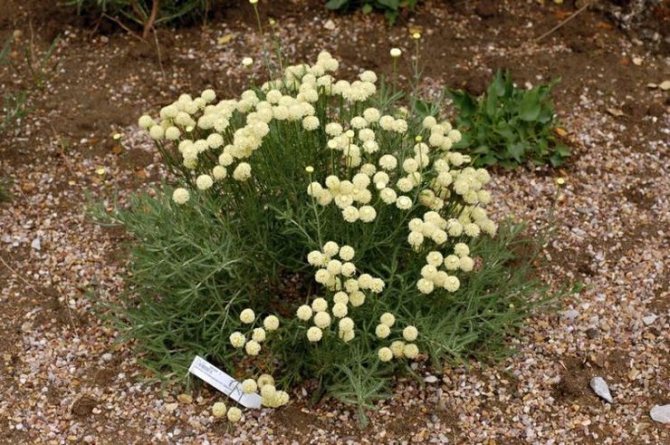

Heat-loving vigorous species, the height of which reaches one meter. A distinctive feature is the spherical yellow inflorescences and delicate foliage. The plant grows well on any type of soil with good air permeability and lack of moisture stagnation. The best varieties are Pritty Carol and Weston. These undersized varieties do not exceed 16 centimeters in height.
Cypress Santolina (Santolina chamaecyparissus)


The second name is silver santorina - the most common species, which has its own dwarf varieties. The best of them are Small Nels, Nana, Edward Bowers. The garden flower culture is distinguished by a bright and attractive aroma, compactness, as well as splendor and abundance of flowering. The average height of the bush is about 50 centimeters. It differs from other species in the color of the leaf mass, which changes from a light green hue at an early age to gray and silver in an adult.

